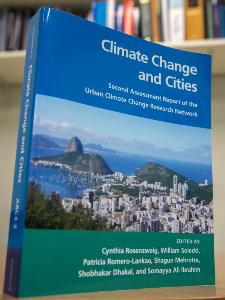The book 'Climate Change and Cities' analyzes the consequences of global warming
25/03/2019
Maíra Menezes (IOC/Fiocruz)
 For five years, scientists from five continents have worked to gather updated data on the impacts of climate change on cities and the measures that can be taken to address the phenomenon. The effort, which was supported by more than 400 experts, was led by the Urban Climate Change Research Network (UCCRN), an international consortium that connects researchers from approximately 150 cities across the globe. The result is in the book Climate Change and Cities: Second Assessment Report of the Urban Climate Change Research Network, published by the Cambridge University Press.
For five years, scientists from five continents have worked to gather updated data on the impacts of climate change on cities and the measures that can be taken to address the phenomenon. The effort, which was supported by more than 400 experts, was led by the Urban Climate Change Research Network (UCCRN), an international consortium that connects researchers from approximately 150 cities across the globe. The result is in the book Climate Change and Cities: Second Assessment Report of the Urban Climate Change Research Network, published by the Cambridge University Press.
With a broad review of the scientific literature and more than 115 case studies, the publication points out ways for the urban transformation needed to make cities more resilient and sustainable. To face climate change, the best is having coordinated mitigation strategies - reducing greenhouse gas emissions - and adaptation - by preparing cities for the new climate conditions. In addition to analyzing the consequences of climate change from the point of view of cities, the book provides concrete examples of success and failure in developed and developing countries. "This information is valuable to support the measures of managers and researches”, says Martha Barata, a researcher at the Oswaldo Cruz Institute (IOC/Fiocruz), who is part of the publication’s organizing committee and coordinates the chapter on human health. Martha is also coordinator at the Urban Climate Change Research Network Latin America Regional Hub (UCCRN-AL), hosted by IOC/Fiocruz in partnership with the Center for Integrated Studies on Environment and Climate Change at Coppe-UFRJ (Climate Centre/Coppe-UFRJ).
Regional diversity
With projections for 153 cities, including ten in Brazil, the book points out that temperatures can rise from 1.7°C to 5°C by 2080, while sea levels in coastal areas should increase from 21 cm to 118 cm. Heat waves, floods, rains and droughts are examples of phenomena that will become more frequent and intense due to climate change, which will have a direct impact on urban areas. In its 16 chapters, the report analyzes the impacts of this scenario on issues such as disasters, urban planning, human health, environmental justice, economy, biodiversity, coastal zones, energy, water, transportation, housing, solid waste and governance. The publication also includes a summary for city leaders, which was presented at the 21st Conference of the Parties (COP-21) in Paris in 2015, with preliminary conclusions from the report.
According to Martha, the book updates and broadens the range of subjects discussed in the first UCCRN report, published in 2011. "All the chapters consider the benefits for cities, not only for the future but for the present. For example, expanding green areas in cities to reduce heat islands can generate immediate benefits for the health of the population by contributing to improved air quality and generating opportunities for physical exercise”, she says, citing the 'one million tree' project, implanted in New York, as an example. She added that the report highlights the progress of research on climate change and cities, especially in developing countries. "In 2011, there was almost no data available on Latin America, but now we have more than twenty case studies from the region. This is important because there are significant regional differences. For example, air pollution is the most researched issue in temperate countries. In tropical areas, there are a significant number of studies relating to vector-borne diseases", the researcher said.
One of the case studies in the book addresses the impact that the rains had on the Serrana Region of the state of Rio de Janeiro in 2011. In addition to causing more than 800 deaths in landslides and floods, the disaster increased the number of infectious diseases transmitted. In Nova Friburgo, cases of leptospirosis increased from seven in 2010 to 167 in 2011, while dengue fever cases increased from 31 to 936. The social cost of diseases, including healthcare costs and loss of productivity, was estimated at between US$ 50,000 and US$ 280,000. For scientists, this data can support the assessment and implementation of preventive measures, since "post-disaster" expenses may outweigh the investment to prevent the damage.
Financial perspective
Financing the measures is one of the subjects that was not published in the report. According to estimates, the cost of adapting to climate change may be 80 to 100 billion per year, with 80% of that spent in urban areas. Since cities will not be able to afford the investments alone, there are projects in the book that are designed to include the private sector in the measures. One of them is Tokyo's carbon trading program, which sets an annual quota for large energy consumers and forces those consumers who emit too much to buy quotas from those who have cut their emissions.
Risks in coastal areas is another subject highlighted for the first time. The report points out that, given the population growth rate in coastal cities, sea levels rising between 10 cm and 21 cm will cause 411 million people to live in areas at risk of flooding in 2060. Scientists say the cost to protect these areas may reach US$ 12 billion to US$ 71 billion by 2100, but that cost is still smaller than what will cost to repair it, if nothing is done. Construction of defense structures and natural solutions such as mangrove and dune recovery are seen as possibilities, alongside projects to prepare the physical infrastructure of cities and their inhabitants to deal with the increased frequency of flooding.
Ways forward for transformation
In addition to describing sector measures, the book points out five ways to achieve the urban transformation needed to cope with climate change. Firstly, integrate mitigation and adaptation. Secondly, coordinate short-term disaster risk reduction and adapt to climate change in the long run. Thirdly, generate information on climate-related risks with scientists and a wide range of stakeholders taking part, including different political-administrative levels, economic actors and the general public. Fourthly, focus on disadvantaged populations such as the poor, the elderly, women, minorities and recent immigrants, who are often more vulnerable to climate change. Finally, proceed by building networks of governance, financing and production of knowledge, to enable the planning, implementation and coordination of measures. "These ways forward have been adopted to varying degrees by cities around the world that are engaged in preparing for climate change. The evidence points out that this is an urgent transformation and it is important to integrate the climate perspective into planning urban interventions since the later cost may be much higher”, warns Martha.


